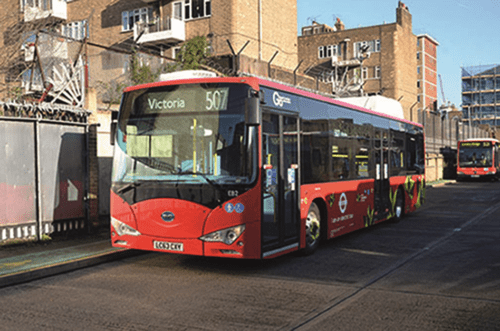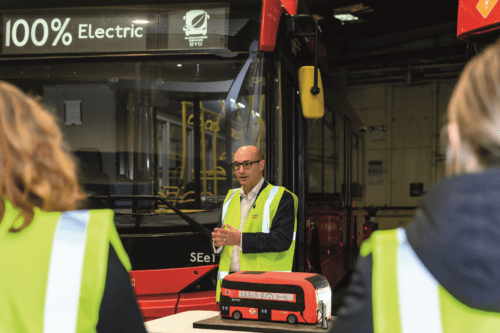
London’s first modern electric bus entered service over a decade ago. Operator Go-Ahead London celebrated the anniversary in December at its Camberwell depot
Go-Ahead London marked a decade of emission-free buses in London in mid-December with a celebration at its Camberwell depot. The operator estimates that since introducing the first of its modern-generation of electric buses to the capital’s streets, it has saved around 40,000 tonnes of carbon dioxide emissions, delivering a benefit equivalent to taking 24,000 cars off the road.
On 18 December, the operator hosted a celebration at its Camberwell depot to mark the 10th anniversary of the operation of London’s first modern day emission-free bus, which was trialled on the same date in 2013. The initial two buses were BYD K9E models, rather than the BYD ADL buses which have become a familiar sight since. Operated by Go-Ahead’s London General division, they were based at its operator’s Waterloo depot and used on former Red Arrow routes 507 and 521; a further four electric single-deck buses manufactured by Optare were introduced to the city shortly afterwards, in the first half of 2014, with financial support from the DfT’s Green Bus Fund, and used on route H98, starting London on its route to a cleaner transport future. The city’s operators now have over 1,000 zero-emission buses in service between them on Transport for London (TfL) routes.
As part of the Camberwell event, pictures were displayed of the ‘clean bus of the future’ drawn by pupils from local schools and guests were served a zero-emission bus themed birthday cake.
Go-Ahead London alone operates 520 zero-emission buses on behalf of TfL and expects to increase this number to 1,000 by the end of 2026, which will account for almost half the company’s fleet. Across the UK as a whole, the Go-Ahead Group now operates 670 zero-emission buses and is shortly to deploy an additional 106 in Oxford, part funded by the Government’s ZEBRA scheme.
In 2022, Go-Ahead London opened a Zero Emission Centre for Excellence to develop ways of optimising operation of zero emission buses – including maximising energy efficiency, standardising maintenance, bringing down the cost of charging infrastructure and extending the lifespan of batteries. The company’s Managing Director David Cutts said: “It’s hard to believe it’s been 10 years since our first electric bus hit the road. The technology has developed at a rapid pace and electric buses are rapidly become the norm, rather than the exception, on London’s streets.
“We’re proud to work in partnership with Transport for London to deliver cleaner air and quieter journeys for Londoners. The Go-Ahead Group as a whole has been able to take experience from London and apply it to the roll-out of zero emission buses across the UK.”

Proud milestone
TfL’s Head of Buses Business Development Tom Cunnington added: “London’s red buses are iconic and are some of the greenest in the world, with the lower CO2 emissions per passenger kilometre compared to other global cities like New York, Paris and Vancouver. With more than 1,300 zero-emission buses on our roads, our programme of decarbonising the fleet is playing a crucial role in the journey to net-zero. Zero-emission buses help Londoners breathe cleaner air and reduce the impact of road transport on our environment.
“We’re really proud to be celebrating this milestone with Go-Ahead London who are marking 10 years of its emission-free electric bus services on our roads. We are working closely with capital’s bus operators to convert the whole fleet and remain on track to be a fully zero-emission fleet by 2034, which could be accelerated to 2030 with further Government funding.”
One of the two original buses survives in the care of the London Bus Museum, where it is now a static exhibit. EB2, LC63 CXY, was new in 2013 and remained in service until 2018; CBW took a drive of one and reported on the experience back in issue 1171. Its largely standee layout gave space for just 21 seated passengers, plus 19 more standing. Powered by BYD’s lithium-iron phosphate batteries, some of which were housed in cabinets above the front wheels, the two buses, numbered EB1 and EB2, were based at the cramped Waterloo depot, which opened in the early 1980s as a Red Arrow garage. In the 1990s it had an allocation of traditional London stock in the form of AEC Routemasters for route 11, but has also been home to many less usual types used on Red Arrow routes, including Leyland Nationals, replaced in 2002 by Mercedes-Benz Citaro articulated buses, which displaced the remaining Routemasters to Stockwell garage. September 2009 saw the articulated Citaros replaced by 12m Citaros, which in turn gave way to the BYD ADL electric fleet which followed EB1 and EB2. On 29 April last year, routes 507 and 521, which the two buses were used on, were withdrawn; Waterloo now operates routes 153 and 214.
The two initial electric buses took between four and five hours to fully charge overnight, sufficient to carry out a full day’s work, at around 150 miles, without the need to recharge.

GO-AHEAD LONDON



